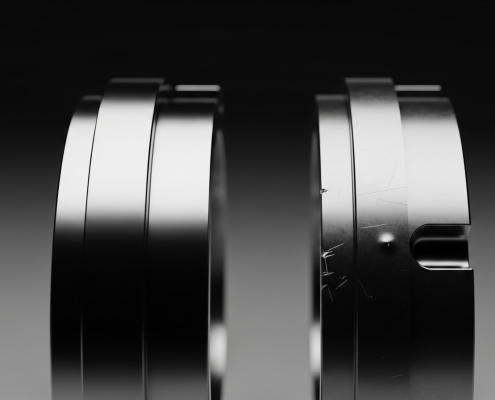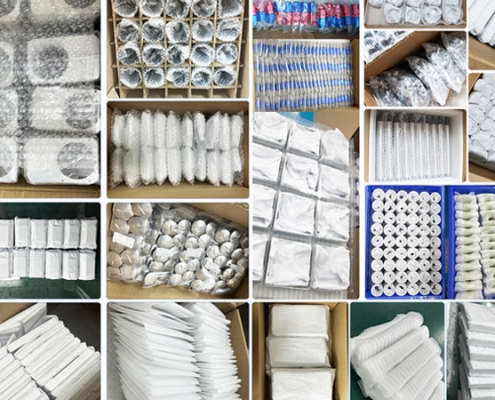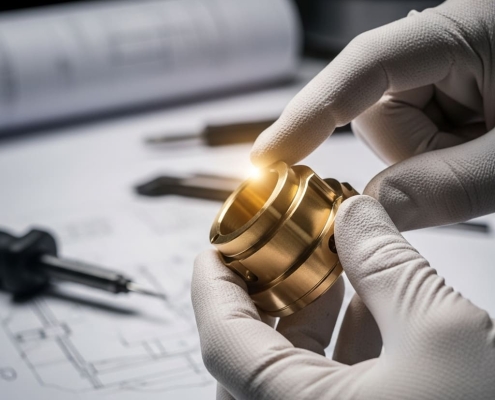A Guide to Controlling Scratches, Bumps, and Dings in CNC Machining for CNC Machining Parts – Insights for CNC Machining Manufacturer in CNC Machining China
Achieving an impeccable surface finish is paramount in the realm of CNC machining. This is not merely an aesthetic preference but a fundamental requirement that profoundly impacts functionality, performance, and customer satisfaction for any CNC machining manufacturer or supplier. It directly reflects the quality and professionalism of CNC machining manufacturers. Scratches, bumps, or dings can instantly lower the perceived value of a product, while flawless finishes enhance brand reputation and build lasting customer trust.
Our commitment as a source manufacturer in CNC machining China is to deliver parts that exceed expectations in every dimension. This includes an unwavering focus on surface quality.
Impact on Functionality and Performance: Why Flawless Surfaces Matter?
The surface integrity of CNC machining parts directly influences their operational effectiveness. Surface defects, even microscopic ones, can act as stress concentrators.
These imperfections can initiate cracks, significantly reducing the fatigue life of critical components. This is especially true for parts used in demanding applications like aerospace or medical devices.
Moreover, surface irregularities can increase friction between mating surfaces. This leads to accelerated wear and tear, reducing the overall lifespan of the assembled product.
Precision fit and optimal performance in complex assemblies rely heavily on smooth, consistent surfaces. Any deviation can compromise the part’s intended function. For example, a slight scratch on a sealing surface could lead to leaks, while a bump on a bearing race could cause premature failure. Our full-chain quality control ensures these issues are proactively addressed.
At VMT, we enforce stringent quality control with 8 dedicated oxidation checks to ensure every part meets the highest standards. By preventing rework and rejection, we not only protect profitability but also safeguard customer confidence. Our commitment to defect-free delivery and transparent pricing provides clients with a strong performance-to-price advantage, making surface quality one of our core competitive strengths.
Economic Implications: Rework, Rejection, and Customer Trust for any CNC Machining Supplier
Surface defects carry significant economic consequences for CNC machining suppliers. Reworking parts is a costly and time-consuming process.
It involves additional labor, machine time, and material consumption, all of which erode profit margins. In many cases, defects are irreparable, leading to outright part rejection.
Rejected parts represent a complete loss of investment in materials, machining, and labor. This directly impacts the profitability and efficiency of operations.
More critically, repeated quality issues can severely damage customer trust. Loss of trust often results in canceled orders and the search for a new CNC machining manufacturer.
Our transparent pricing logic and commitment to quality help mitigate these risks. We aim for high-performance-to-price ratio by optimizing processes and ensuring defect-free delivery.
Understanding Common Surface Defects in CNC Machining: Scratches, Bumps, and Dings
Effective defect prevention begins with a clear understanding of the types of surface imperfections that can occur. Scratches, bumps, and dings are among the most prevalent.
Identifying their root causes is crucial for developing targeted prevention strategies in CNC machining. Our technical team, with its deep technical expertise, excels in this analysis.
Categorizing and Identifying Surface Defects
Understanding the nature of each defect allows for precise corrective and preventive actions. We approach defect identification with a systematic methodology.
Our 12-stage quality control process begins with detailed analysis of potential issues at the quotation and design stages. This proactive approach minimizes defects.
We categorize common surface defects based on their appearance, typical causes, and primary prevention methods. This systematic approach supports continuous improvement.
For effective defect management in CNC machining metal and other materials, consider the following table:
| Defect Type | Common Causes | Appearance | Primary Prevention Strategy |
|---|---|---|---|
| Scratches | Swarf accumulation, improper handling, tool dragging, worn tools | Linear marks, varying depth, often directional | Meticulous cleaning protocols, optimized tooling, careful handling of CNC Machining Parts |
| Bumps/Burrs | Tool wear, incorrect feed/speed, material tear, insufficient chip evacuation, material push-out | Raised material, sharp edges, irregular protrusions | Proper tool selection/maintenance, optimized cutting parameters for CNC Machining, effective deburring |
| Dings/Dents | Impact during handling, accidental dropping, poor workholding, inadequate packaging | Indentations, localized deformation, loss of material integrity | Secure workholding, careful post-processing, protective packaging by CNC Machining Suppliers |
Our Proactive Strategies for Scratch Prevention in CNC Machining
Preventing scratches requires a multifaceted approach that encompasses every stage of the CNC machining process. From initial material handling to final part delivery, vigilance is key. As a leading CNC machining manufacturer in CNC machining China, we integrate these proactive strategies into our daily operations. Our goal is zero surface defects.
1. Meticulous Material Handling & Storage
Scratch prevention starts long before machining begins. At VMT, raw stock is stored on clean, flat surfaces with protective coverings or separators to avoid abrasion. During transport, forklifts and lifting equipment are fitted with non-marring pads or slings to safeguard material surfaces. Our 5000㎡ facility is equipped with designated storage areas to ensure organized and contamination-free handling. For finished parts, we use protective trays, lined racks, or custom compartments to prevent contact damage, while specialized trolleys secure parts during internal movement. This meticulous handling reduces the risk of scratches from start to finish.
2. Optimized Tooling & Cutting Parameters
The condition and selection of cutting tools play a decisive role in achieving flawless surfaces. Our engineering team carefully selects tool materials, geometries, and coatings tailored to each specific material. For softer alloys like aluminum 6061 and 7075, sharp, polished tools with high rake angles are used to ensure clean cutting. Harder alloys, including Inconel 718, require coated tools for durability and reduced friction. By fine-tuning feed rates, spindle speeds, and depths of cut, our technicians continuously optimize machining programs. This precision not only improves yield rates by over 5% but also boosts efficiency by more than 15% compared to industry norms.
3. Effective Coolant & Lubrication
Coolant strategy is another critical factor for surface quality. We deploy advanced coolant delivery systems that ensure chips are evacuated efficiently, while friction and heat are minimized. Each coolant type is selected based on the material to be machined, ensuring optimal lubrication and cooling. By preventing chip re-cutting and tool adhesion, this process maintains smooth surface integrity and reduces the risk of scratches during machining.
4. Secure Fixturing & Workholding
Stable fixturing is essential for protecting surface quality under cutting forces. Our engineers design custom fixtures to achieve maximum rigidity, while clamping pressure and contact materials are carefully balanced to avoid part deformation. For delicate or complex geometries, vacuum fixtures and soft jaws provide secure yet gentle holding. Combined with our advanced 5-axis CNC and mill-turn equipment, this ensures parts remain stable throughout machining, eliminating chatter marks and surface imperfections.
5. Machine Maintenance & Cleanliness Protocols
Clean, well-maintained machines are fundamental to preventing scratches. Accumulated swarf inside a machine can easily mar finished surfaces, so we enforce rigorous daily and weekly cleaning routines, including thorough chip removal and coolant sump maintenance. In addition, we perform regular spindle and axis calibration checks to maintain precision across all machining operations. With more than 80 high-precision CNC machines under strict maintenance schedules, we guarantee consistent accuracy and defect-free finishes.
Summary: Scratch Prevention Strategies
| Category | Key Practices | Impact on Surface Quality |
|---|---|---|
| Material Handling & Storage | Protective storage, non-marring lifting, custom trays | Prevents abrasion before/after machining |
| Tooling & Cutting Parameters | Optimal tool selection, coatings, parameter fine-tuning | Reduces drag, tool marks, and heat damage |
| Coolant & Lubrication | Advanced coolant delivery, material-specific fluids | Prevents chip re-cutting and thermal scratches |
| Fixturing & Workholding | Custom fixtures, vacuum holding, balanced clamping | Minimizes vibration, chatter marks, and deformation |
| Machine Maintenance | Regular swarf removal, calibration, cleaning schedules | Ensures consistent precision and defect-free surfaces |
Mitigating Bumps and Burrs During and After CNC Machining Processes
Bumps and burrs are common byproducts of metal cutting. While often small, they can severely impact part functionality, assembly, and aesthetic appeal.
Effective mitigation requires attention at the design stage and through various post-machining treatments. Our process control is designed to address these challenges comprehensively.
1. Design for Manufacturability (DFM)
The most effective way to reduce burrs is to prevent them at the design stage. Our engineers provide free DFM reports and recommendations during quotation, identifying burr-prone features such as sharp edges or intersecting holes. Design adjustments like chamfers, fillets, or optimized tolerances help minimize burr formation and lower production costs.
2. Advanced Deburring Techniques
When burrs do occur, we apply the most suitable removal method: manual precision deburring for critical edges, vibratory finishing for batch parts, robotic deburring for consistent high-volume production, and chemical or electrochemical deburring for delicate geometries. Each process is selected based on material, geometry, and finish requirements.
3. Edge Treatment Strategies
For critical parts, we go beyond deburring with edge radiusing and chamfering to ensure smooth transitions, reduce stress concentrations, and improve fatigue resistance. Using 5-axis and mill-turn equipment, we deliver precise edge control for complex parts, meeting stringent standards in industries such as aerospace and electronics.
Preventing Dings and Dents in Finished CNC Machining Parts
Dings and dents are typically caused by impact, often occurring during post-machining handling or transportation. Preventing these requires a robust system of safeguards.
As a CNC machining manufacturer focused on quality, we extend our defect prevention efforts beyond the machine. Our focus is on protecting finished CNC machining parts.
1. Post-Machining Handling & Transport
Parts are handled with gloves, stored in protective trays or foam inserts, and transported on specialized trolleys—ensuring no contact damage after machining.
2. Protective Packaging Solutions
Custom packaging such as blister packs, foam inserts, and reinforced cartons prevents scratches, bumps, and dents, guaranteeing safe delivery even in international shipping.
3. Automated Handling Systems
Robotic arms and conveyor systems minimize manual handling, reducing human error and ensuring consistent, gentle part movement throughout production.
Case Study: A CNC Machining Manufacturer‘s Success Story in Eliminating Surface Defects on High-Value CNC Machining Metal Components
As a leading CNC machining manufacturer in CNC machining China, we constantly strive for perfection. Our collaboration with industry giants like DJI, though indirect, exemplifies our capabilities.
A specific scenario involved a customer facing recurring micro-scratches on high-value aluminum alloy components destined for advanced robotic applications. These were critical CNC machining metal parts requiring flawless surfaces. Our team, leveraging deep technical expertise and process control, implemented a comprehensive solution. This strategy addressed the root causes of the defects.
First, we initiated a thorough DFM analysis at the quotation stage. Our engineers identified specific features and machining strategies that were contributing to micro-scratch formation. We recommended slight design modifications to eliminate sharp internal corners. These modifications previously trapped swarf, leading to surface abrasion.
Next, we optimized tooling. We transitioned to specialized, highly polished carbide end mills with optimized geometries and advanced coatings for aluminum alloy specialization. These tools minimized material friction and promoted superior chip evacuation.
Our programming and debugging technicians, through their “learn from each other” mechanism, refined cutting parameters. They reduced feed rates for finishing passes and increased spindle speeds, achieving a finer surface finish. Critically, we introduced a new, 12-stage quality control framework tailored for these parts. This included IPQC inspections every two hours. IPQC identified potential issues early, allowing for immediate adjustments to machining parameters. This proactive monitoring was key to preventing defects throughout the production run.
Our material handling protocols were also enhanced. We implemented custom-designed, soft-lined trays for post-machining handling and transportation. This ensured parts never came into contact with abrasive surfaces.
For final delivery, each component was individually placed in a custom-fit blister pack, then securely packed in cushioned boxes. This robust protective packaging eliminated transit damage.
The results were transformative. The customer experienced a reduction in surface defects to near zero, significantly improving their product quality and delivery timelines. Our refined machining and quality assurance processes led to a yield rate increase of over 5% for these complex parts. This directly contributed to cost savings for the client.
In Conclusion
Achieving surface perfection in CNC machining requires an end-to-end approach, from DFM optimization and precise tooling control to clean machining environments, secure workholding, and post-processing safeguards. As a source manufacturer in CNC machining China, we combine 5-axis capability, ISO/IATF certifications, and a 12-stage quality control process to deliver defect-free parts. With advanced deburring, protective packaging, and continuous investment in automation and process innovation, we ensure both functionality and aesthetics.
Frequently Asked Questions
What is the most common cause of scratches in CNC Machining Metal components, and how can it be addressed?
The most common cause of scratches in CNC machining metal components is often related to inadequate chip management and improper handling. Fine metal chips (swarf) can get trapped between the cutting tool and the workpiece, or between the workpiece and fixtures, leading to abrasive marks.
How does material hardness and brittleness affect the propensity for dings and bumps during CNC Machining?
Material hardness and brittleness significantly influence the likelihood of dings and bumps. Softer, more ductile materials (like some aluminum alloys) are more prone to dinging and denting from impacts due to their malleability. However, they may form burrs more readily due to material tear.
Conversely, harder, more brittle materials (like hardened steels or ceramics) are less likely to ding but are more susceptible to chipping or fracturing upon impact. Understanding these material properties helps in selecting appropriate handling, workholding, and machining parameters to prevent defects.
Can automated deburring completely eliminate manual post-processing for complex CNC Machining Parts?
While automated deburring techniques can significantly reduce manual post-processing, they may not completely eliminate it, especially for highly complex CNC machining parts with intricate geometries or very tight tolerance requirements. Automated systems excel at consistency and high-volume operations.
However, for extremely delicate features, critical edges, or internal geometries that are difficult for automated tools to reach, manual deburring by skilled technicians often remains necessary to achieve the desired surface finish and precision. Our specialized processing expertise bridges this gap.
How can a small to medium-sized CNC Machining Supplier effectively implement these comprehensive control measures within a limited budget?
A small to medium-sized CNC machining supplier can implement these measures effectively, even with a limited budget, by focusing on strategic investments and process optimization. Start with robust training for staff on proper handling and cleaning protocols.
Invest incrementally in appropriate tooling and improved workholding. Leverage DFM collaboration with clients to prevent issues at the design stage. Prioritize clear, simple packaging solutions. For detection, utilize accessible inspection tools like magnifiers and surface comparators, gradually upgrading to more advanced equipment as budget allows. Our flexible MOQ and cost-effective solutions support partners of all sizes.







